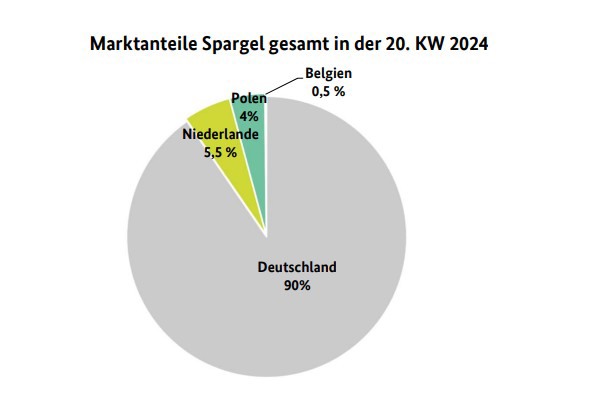Asparagus availability continued to expand unabated, particularly domestic deliveries experienced another surge. The summer weather not only accelerated the growth of the spears in the fields but also improved storage options. However, according to BLE, demand could not always keep up with the increased presence. Therefore, traders were occasionally forced to lower their previous prices if they wanted to avoid larger inventories.

Towards the Pentecost weekend, customers picked up their pace slightly, which led to price increases in various instances. Nonetheless, surpluses could not always be prevented. In the white asparagus segment, Dutch, Polish, and Belgian batches complemented the assortment, while for the purple offerings, only Dutch products were offered alongside the domestic batches. Green asparagus, besides Germany, came only from Poland, with imports playing only a complementary role.
Apples
Among the domestic offerings, Elstar, Jonagold, and Braeburn dominated the scene, with the significance of Gala and Tenroy being limited. The European assortment was primarily supplemented by Italian Pink Lady and Granny Smith. Overseas shipments visibly increased.
Pears
South Africa dominated the scene with Abate Fetel, Packham's Triumph, and Forelle. Chilean Abate Fetel and Forelle followed in terms of significance. Additionally, a few Argentine Abate Fetel were also imported. Anjou pears were newly added to the assortment, sold in Frankfurt in 18‑kg boxes.
Grapes
Relatively inexpensive Thompson Seedless from India shaped the scene, followed by Crimson Seedless from Chile and South Africa. Other varieties from these countries played a more complementary role. The first Italian offerings were already available.
Strawberries
Domestic batches played the main role, followed by shipments from the Netherlands and Greece. Belgium, Poland, Italy, and Spain were involved in the marketing with very small quantities. The summer weather not only led to an increase in deliveries but also improved demand.
Lemons
Spanish Verna came to the forefront, significantly replacing Primofiori of the same origin in terms of importance. Shipments from Greece, Turkey, and Italy complemented the product range.
Bananas
Supply and demand were adequately matched. Locally, sales options slightly improved. Yet, the prices remained within the usual ranges. Only Munich reported slight price reductions across the entire assortment.
Cauliflower
Domestic offerings prevailed. In addition, Belgian, Dutch, Italian, and Polish batches were available in 6 and 8-count packaging. French and Spanish products were traded in 6-count packs. Thus, a variety of countries were involved in the supply.
Lettuce
For iceberg lettuce, the presence of domestic products had visibly expanded. Concurrently, the significance of Spanish products decreased according to the season. Head lettuces came from domestic and Belgian sources, while mixed salads came exclusively from domestic sources.
Cucumbers
The assortment of cucumbers consisted of Dutch, Belgian, and German offerings. The availability was not always sufficient to meet the demand. Accordingly, prices climbed upwards, in some cases quite significantly. This led to a noticeable reluctance to purchase.
Tomatoes
Dutch and Belgian shipments formed the basis of the assortment. Offers from Germany, Spain, and Italy complemented the scene. The availability had visibly expanded and often exceeded demand.
Bell peppers
Dutch batches dominated, with Turkish and Belgian participating behind them, with almost identical quantities in the marketing. Domestic and Spanish offers rounded off the product range. Demand was satisfied easily. Nevertheless, prices often trended upwards.
Source: BLE
